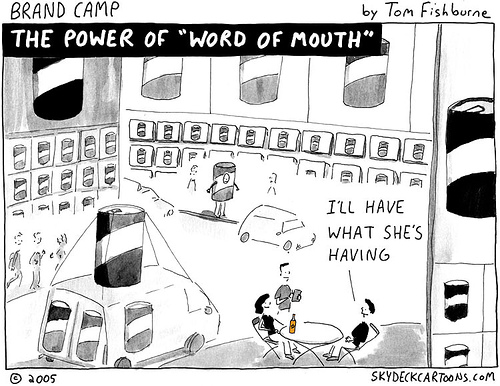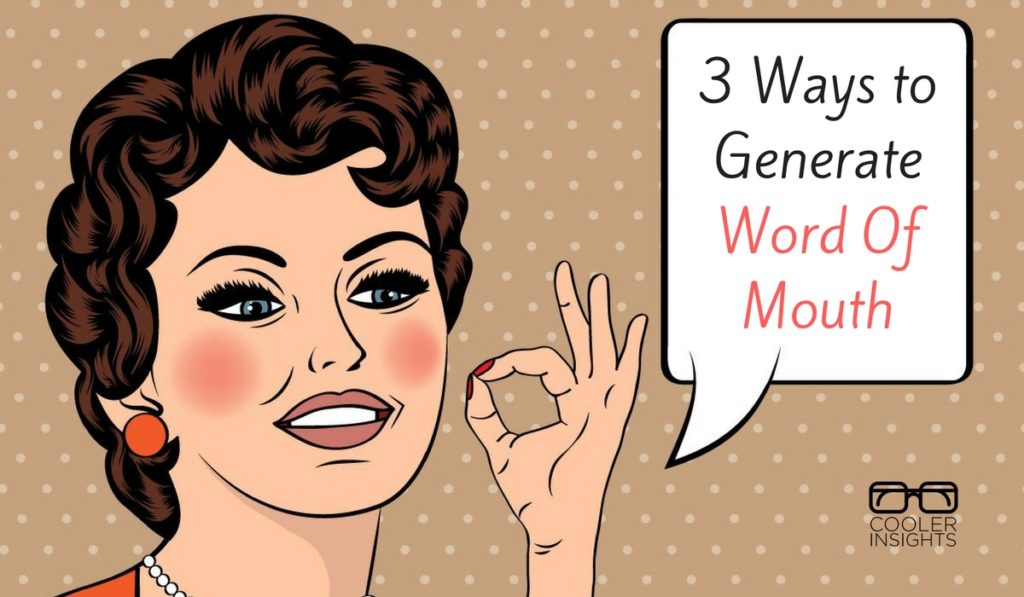In the age of social and digital media, your ultimate goal is to create a business that others will share freely about. That in a nutshell is what Word Of Mouth is all about.
But how can you increase the shareability of your business? What techniques can you use to improve Word Of Mouth for your business?
An evergreen marketing concept that never loses its lustre, Word Of Mouth is a term that is defined by the Word of Mouth Marketing Association (WOMMA) as follows:
“Word Of Mouth: the act of a consumer creating and/or distributing marketing-relevant information to another consumer” – Word Of Mouth Marketing Association
Unlike other forms of advertising or marketing, Word Of Mouth (WOM) marketing usually has greater credibility because it comes from trusted sources of information like your family members, friends or associates.
Five Components of Word Of Mouth
According to WOMMA, the process of word-of-mouth can be represented through five components:
1) The Word-of-Mouth Unit or what we can identify as the contents of the message that gets disseminated.
2) The Participants in a word of mouth process, ie those who are sharing information to each other. This can be one-to-one, one-to-many, or many-to-many depending on the connectivity of participants to each other.
3) The Places or venues where communication takes place. They can be both real life locations (coffeeshops, pubs, offices, schools, homes) or online social networking platforms like forums, Facebook, WhatsApp, Twitter, Blogs, Emails and others.
4) The Actions that are desired from the Word Of Mouth exercise. These will be the tasks that we want recipients of the message to do. They can either visit a venue, perform an activity, purchase something, add on to the message, or convey it to others.
5) The Outcomes of that communication and its end results. In a commercial enterprise, it should lead to either higher sales or greater brand awareness, while a non-profit organisation may want to elicit greater support for its cause in terms of donations, participation, or audience numbers.
Variations of Word Of Mouth Marketing
Is there a difference between WOM, Buzz and Viral Marketing?
Well, they are all related to one another, with the difference being how they are triggered and generated. While many folks use these terms interchangeably, there are slight nuances in how each strategy is used.
Buzz Marketing Defined
Buzz Marketing is usually used more loosely than WOM. There appears to be several different versions of this term floating around.
I like the definition by Mark Hughes (author of the book Buzz Marketing) best. He described it as follows:
“Buzz Marketing: Capturing the attention of consumers and the media to the point where talking about your brand becomes entertaining, fascinating, and newsworthy.” – Mark Hughes
From the above, you can see that buzz marketing frequently involves generating something sensational which is strong enough to hit the headlines in the daily press.
Buzz also comes with “news-making” elements that may include excitement, imagination, theatricality, shock appeal, surprise and often controversy.
Most examples are buzz are time-limited – they normally die down after a couple of days (or weeks at most) before they are supplanted by other news. Content marketers often ride on the buzz generated by a piece of breaking news to trigger interest in their stories – a process called Newsjacking.
Examples include half.com (an entire town named “half”), Ashton Kutcher’s humungous Twitter following, and I guess any major Internet sensation (like Gangnam Style, and Susan Boyle).
Viral Marketing Explained
Viral marketing, on the other hand, is usually an online version of WOM which normally entails some form of stealth marketing where the identity of the perpetrator may not be known from the onset. It has a more underground and covet feel to it, and is normally conducted on a smaller and more “experimental” scale than a buzz marketing campaign.
In most people’s minds, viral marketing usually take the form of a viral video conveyed through video networks like YouTube.
Again, like buzz marketing, there is usually a time limit to how long viral campaigns can last. Lots of alcohol brands employ online viral videos or games in their campaigns.
Examples of viral marketing include Hotmail, the subservient chicken, the Million dollar homepage and others.
Enduring Word Of Mouth
I have created another form of Word of Mouth marketing called “Enduring WOM” (for want of a better name) which may or may not overlap with Viral or Buzz marketing.
This is the kind of Word Of Mouth strategy which enterprises may want to aim for. One that is more sustainable and enduring over the long-haul with a unique competitive advantage that transcends fads and trends.
Unlike other more ephemeral forms of WOM, your focus here is to cultivate superior customer relationships, develop remarkable products, and create premium yet unique experiences. In other words, you should turn your brand into a Purple Cow.
While enduring WOM may include elements of viral or buzz marketing, it proffers a financially sustainable longer-term approach which offers something of value to customers long after the initial hype is gone. Thus, generating long-term WOM is a function of your business model rather than your marketing campaign.
Examples of businesses in this category include Nordstrom, In-N-Out Burger and Zappos.com.
Virality, Buzz and Enduring WOM?
The relationship between all three can perhaps be conveyed through the following diagram:
Is there an appropriate form of WOM for one to consider? Well, this depends on your individual circumstances and needs.
If you are starting a business or launching a new product, you may want to initiate a viral campaign or generate some buzz so that there is a greater initial brand awareness.
Once the business gets going and customers start streaming in, a longer-term enduring WOM strategy (providing top-notch service, unparalleled after sales support, and/or a unique experience) may be more important.
For major product launches, you may want to incorporate both buzz marketing and viral tactics coupled with longer-term WOM strategies.
If you are targeting a more youthful and niche market, something with a more underground feel, ie a viral marketing approach may work better.
Of course, there is no hard and fast rule on what works or what doesn’t. Sometimes, external factors which you cannot control do play a major role in the success of your WOM campaign.
Whatever the case may be, your should look towards WOM not simply to become an overnight sensation but to develop a sustainable way of cultivating positive and enduring long-term relationships with your customers.
PS – There are actually 11 forms of WOM marketing in WOMMA’s website here! Do read them if you are keen to know more.

Courtesy of maiskelin



hey
very nicely written article, keep up the great work
thank you